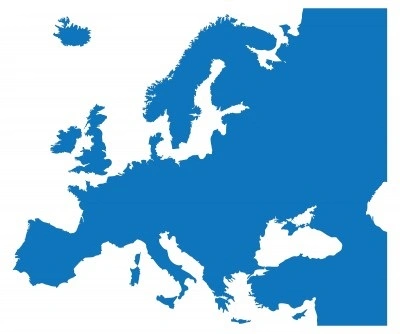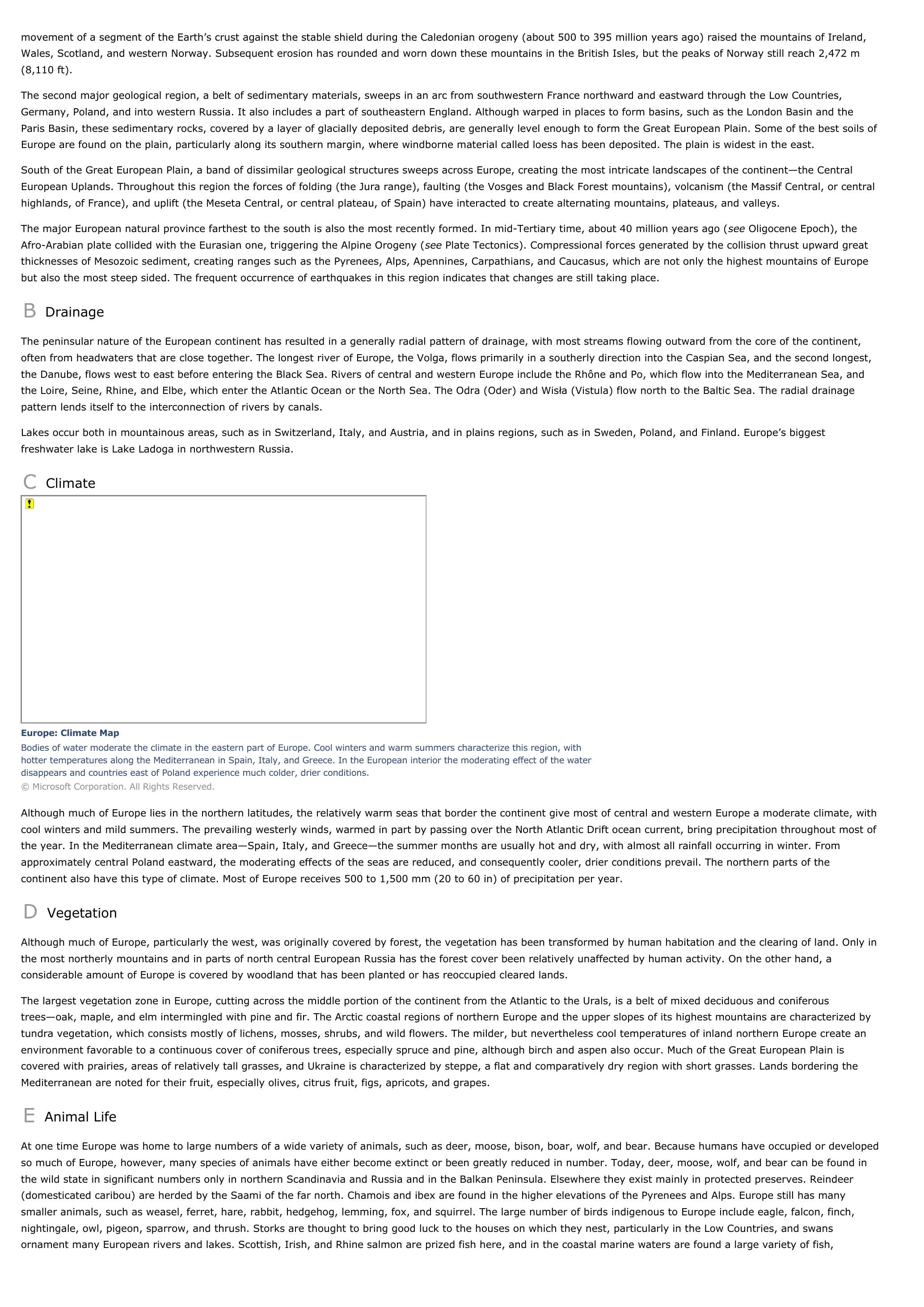Europe - geography.
Publié le 26/05/2013

Extrait du document


«
movement of a segment of the Earth’s crust against the stable shield during the Caledonian orogeny (about 500 to 395 million years ago) raised the mountains of Ireland,Wales, Scotland, and western Norway.
Subsequent erosion has rounded and worn down these mountains in the British Isles, but the peaks of Norway still reach 2,472 m(8,110 ft).
The second major geological region, a belt of sedimentary materials, sweeps in an arc from southwestern France northward and eastward through the Low Countries,Germany, Poland, and into western Russia.
It also includes a part of southeastern England.
Although warped in places to form basins, such as the London Basin and theParis Basin, these sedimentary rocks, covered by a layer of glacially deposited debris, are generally level enough to form the Great European Plain.
Some of the best soils ofEurope are found on the plain, particularly along its southern margin, where windborne material called loess has been deposited.
The plain is widest in the east.
South of the Great European Plain, a band of dissimilar geological structures sweeps across Europe, creating the most intricate landscapes of the continent—the CentralEuropean Uplands.
Throughout this region the forces of folding (the Jura range), faulting (the Vosges and Black Forest mountains), volcanism (the Massif Central, or centralhighlands, of France), and uplift (the Meseta Central, or central plateau, of Spain) have interacted to create alternating mountains, plateaus, and valleys.
The major European natural province farthest to the south is also the most recently formed.
In mid-Tertiary time, about 40 million years ago ( see Oligocene Epoch), the Afro-Arabian plate collided with the Eurasian one, triggering the Alpine Orogeny ( see Plate Tectonics).
Compressional forces generated by the collision thrust upward great thicknesses of Mesozoic sediment, creating ranges such as the Pyrenees, Alps, Apennines, Carpathians, and Caucasus, which are not only the highest mountains of Europebut also the most steep sided.
The frequent occurrence of earthquakes in this region indicates that changes are still taking place.
B Drainage
The peninsular nature of the European continent has resulted in a generally radial pattern of drainage, with most streams flowing outward from the core of the continent,often from headwaters that are close together.
The longest river of Europe, the Volga, flows primarily in a southerly direction into the Caspian Sea, and the second longest,the Danube, flows west to east before entering the Black Sea.
Rivers of central and western Europe include the Rhône and Po, which flow into the Mediterranean Sea, andthe Loire, Seine, Rhine, and Elbe, which enter the Atlantic Ocean or the North Sea.
The Odra (Oder) and Wisła (Vistula) flow north to the Baltic Sea.
The radial drainagepattern lends itself to the interconnection of rivers by canals.
Lakes occur both in mountainous areas, such as in Switzerland, Italy, and Austria, and in plains regions, such as in Sweden, Poland, and Finland.
Europe’s biggestfreshwater lake is Lake Ladoga in northwestern Russia.
C Climate
Europe: Climate MapBodies of water moderate the climate in the eastern part of Europe.
Cool winters and warm summers characterize this region, withhotter temperatures along the Mediterranean in Spain, Italy, and Greece.
In the European interior the moderating effect of the waterdisappears and countries east of Poland experience much colder, drier conditions.© Microsoft Corporation.
All Rights Reserved.
Although much of Europe lies in the northern latitudes, the relatively warm seas that border the continent give most of central and western Europe a moderate climate, withcool winters and mild summers.
The prevailing westerly winds, warmed in part by passing over the North Atlantic Drift ocean current, bring precipitation throughout most ofthe year.
In the Mediterranean climate area—Spain, Italy, and Greece—the summer months are usually hot and dry, with almost all rainfall occurring in winter.
Fromapproximately central Poland eastward, the moderating effects of the seas are reduced, and consequently cooler, drier conditions prevail.
The northern parts of thecontinent also have this type of climate.
Most of Europe receives 500 to 1,500 mm (20 to 60 in) of precipitation per year.
D Vegetation
Although much of Europe, particularly the west, was originally covered by forest, the vegetation has been transformed by human habitation and the clearing of land.
Only inthe most northerly mountains and in parts of north central European Russia has the forest cover been relatively unaffected by human activity.
On the other hand, aconsiderable amount of Europe is covered by woodland that has been planted or has reoccupied cleared lands.
The largest vegetation zone in Europe, cutting across the middle portion of the continent from the Atlantic to the Urals, is a belt of mixed deciduous and coniferoustrees—oak, maple, and elm intermingled with pine and fir.
The Arctic coastal regions of northern Europe and the upper slopes of its highest mountains are characterized bytundra vegetation, which consists mostly of lichens, mosses, shrubs, and wild flowers.
The milder, but nevertheless cool temperatures of inland northern Europe create anenvironment favorable to a continuous cover of coniferous trees, especially spruce and pine, although birch and aspen also occur.
Much of the Great European Plain iscovered with prairies, areas of relatively tall grasses, and Ukraine is characterized by steppe, a flat and comparatively dry region with short grasses.
Lands bordering theMediterranean are noted for their fruit, especially olives, citrus fruit, figs, apricots, and grapes.
E Animal Life
At one time Europe was home to large numbers of a wide variety of animals, such as deer, moose, bison, boar, wolf, and bear.
Because humans have occupied or developedso much of Europe, however, many species of animals have either become extinct or been greatly reduced in number.
Today, deer, moose, wolf, and bear can be found inthe wild state in significant numbers only in northern Scandinavia and Russia and in the Balkan Peninsula.
Elsewhere they exist mainly in protected preserves.
Reindeer(domesticated caribou) are herded by the Saami of the far north.
Chamois and ibex are found in the higher elevations of the Pyrenees and Alps.
Europe still has manysmaller animals, such as weasel, ferret, hare, rabbit, hedgehog, lemming, fox, and squirrel.
The large number of birds indigenous to Europe include eagle, falcon, finch,nightingale, owl, pigeon, sparrow, and thrush.
Storks are thought to bring good luck to the houses on which they nest, particularly in the Low Countries, and swansornament many European rivers and lakes.
Scottish, Irish, and Rhine salmon are prized fish here, and in the coastal marine waters are found a large variety of fish,.
»
↓↓↓ APERÇU DU DOCUMENT ↓↓↓
Liens utiles
- Europe - Geography.
- Religions of Europe and Northern Asia - geography.
- Europe and Central Asia - geography.
- Tiny Countries of Europe - geography.
- Languages of Europe - geography.

































